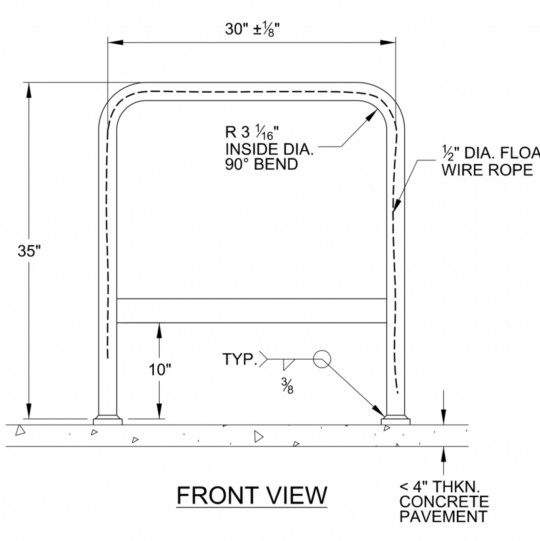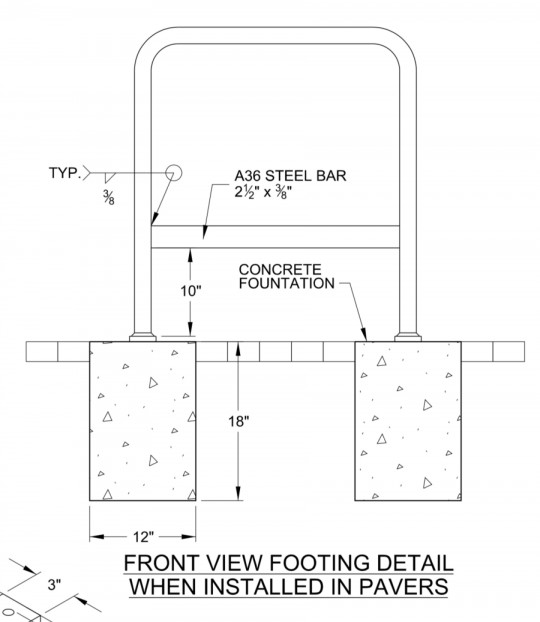Bike parking coverage on BikePortland is sponsored by Huntco.
The City of Portland’s ubiquitous blue “staple” racks are simple (one piece of steel pipe formed into an inverted U and bolted into the pavement) and highly functional — but they’ve also been targeted by thieves.
Now PBOT has engineered a new rack that should be much harder to compromise (PDF of official design specs here). The new design includes a steel crossbar, a wire cable that floats inside the steel pipe, and a stronger method for anchoring the rack to the ground.
The changes come in response to Portland’s bike theft epidemic. Not only are thieves stealing more bikes these days, but they’re doing it more brazenly than ever. The problem has gotten so bad that some people have given up cycling due to fears of losing their bike, especially in the central city where most thefts occur. As we’ve reported here on BikePortland several times over the years, thieves tactics include unscrewing the bolts that hold the racks in the ground and sometimes even sawing right through the pipe. They’ll do just about anything to get a bike free.
Just this morning we learned about a new tactic: Thieves in the U.K. cut through the pipe of a staple rack and then put tape over the cut to hide it from unsuspecting riders.
To thwart these nefarious plots, PBOT has been working on getting a new design on the streets for over a year now. At our Bike Theft Summit in December 2014, PBOT Bicycle Program Specialist Sarah Figliozzi alluded to the new design during a panel discussion. PBOT then worked with members of the Bike Theft Task Force last spring to brainstorm design ideas. Here’s a video presented to the BTTF that shows city maintenance crews testing the new rack with a power grinder…
Advertisement
“While very few of the 6,500 city-maintained bike racks in Portland are damaged intentionally, we did see a spate of sawed-through racks about a year ago,” Brady told us yesterday. “In order to increase security, we decided to see how we could simply and affordably prevent some of the more common ways bikes are stolen by damaging or removing a rack.”
The new design was a collaboration between staffers from PBOT’s Maintenance Operations and Active Transportation divisions. A key feature of the new design is a floating wire rope inside the pipe. PBOT staff tested it with various cutting devices and Brady said the results “were very encouraging.”It took much more effort to cut through the new design, principally because the floating wire rope creates another barrier that drains a power tool’s battery.” The other key feature is the steel bar welded inside the rack about 10-inches off the ground. The crossbar has two purposes: It makes it harder for thieves to slip a u-lock through the top (via a cut in the pipe) or the bottom (via bolts that have been removed). The City of Seattle’s standard bike rack design also utilizes a crossbar.
This new rack will also be tougher for one reason you can’t see. As per the official specs, PBOT instructs installation crews to construct 18-inch deep concrete foundations if the rack is installed on paving stones or concrete less than three inches thick (see image below).
Brady added that despite the new features, the new rack design is just a few dollars more expensive the than old one. That means the racks cost about $85 a piece. With so many of these racks being installed, price is a serious consideration (we highlighted a private company’s design last January that was significantly more expensive).
PBOT hopes to take delivery of their first batch of 300 new racks in a few months. They won’t replace existing racks but every new rack installed from here on out will have the new design.
And while these new racks will keep your bike safer, it’s not time to let your guard down. “It will take much more effort, forethought, strength, and tool power to defeat this new design,” Brady said. “But the best bike theft prevention is still education about the correct lock to use and locking techniques.”
In other Portland bike theft news, a new intern for the Bike Theft Task Force reported for his first day of duty today. Stay tuned to learn more about what he’ll be working on.
— Jonathan Maus, (503) 706-8804 – jonathan@bikeportland.org
BikePortland can’t survive without paid subscribers. Please sign up today.






